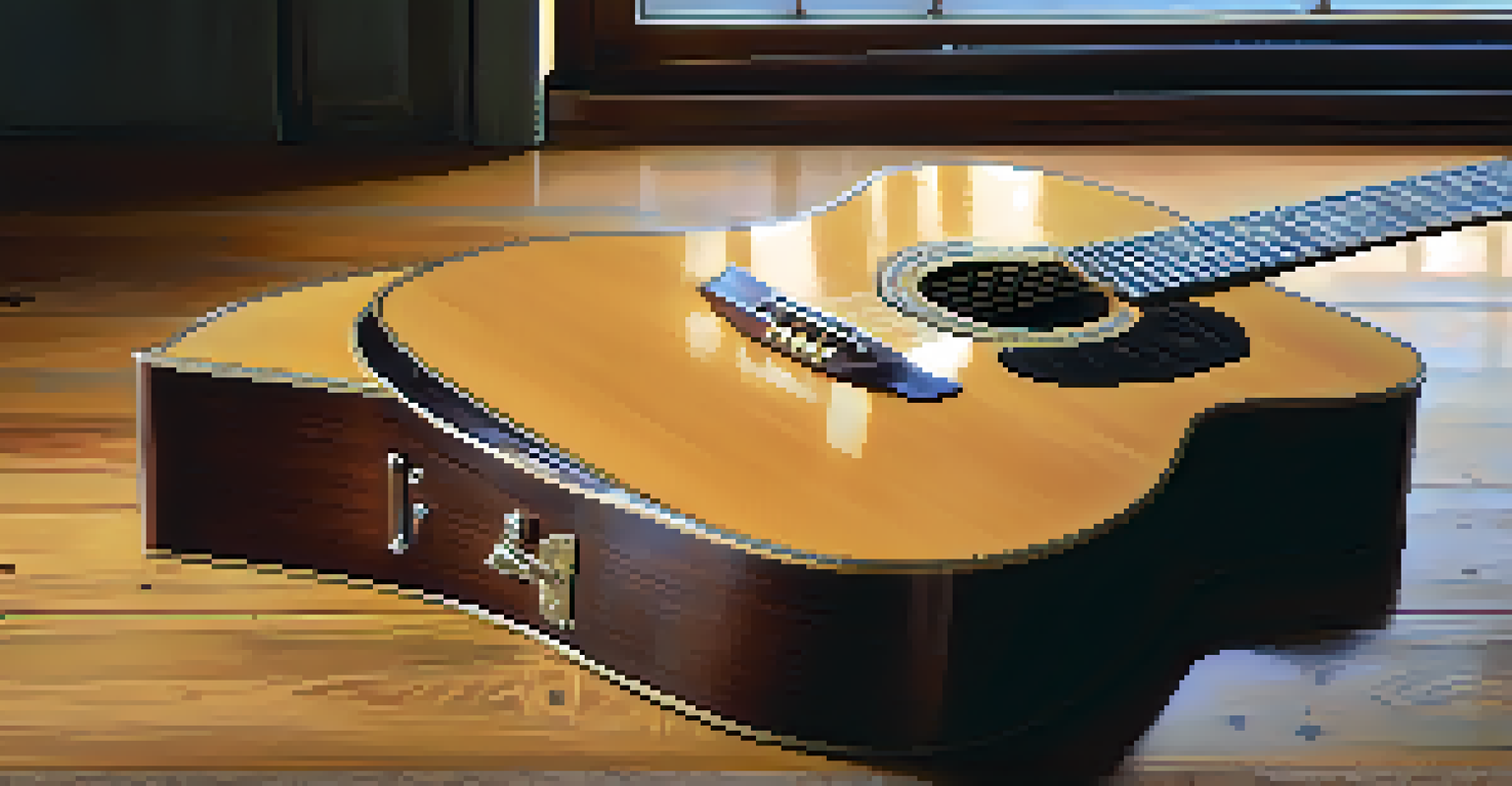Exploring C6 Tuning: Hawaiian and Country Guitar Styles

What is C6 Tuning and Why It Matters
C6 tuning is a unique configuration of guitar strings that provides a rich, resonant sound, making it especially popular in Hawaiian and country music. This tuning typically involves lowering the sixth string to C, giving guitarists a new palette of chords and melodies to explore. By using C6 tuning, musicians can create lush harmonies and intricate melodies that evoke the essence of these vibrant genres.
Music can change the world because it can change people.
The versatility of C6 tuning allows it to be used in both slide guitar and fingerpicking styles, making it a favorite among players who enjoy expressing a wide range of emotions. The distinct sound produced by C6 tuning can transport listeners to a tropical beach or a country road, illustrating the power of musical expression. Understanding this tuning opens new doors for guitarists eager to delve into different stylistic territories.
In essence, C6 tuning serves as a bridge connecting various musical worlds. It enhances the player's ability to convey storytelling through music, which is a cornerstone of both Hawaiian and country styles. So, let's dive deeper into how this tuning shapes the sound of these beloved genres.
Hawaiian Guitar: The Soul of C6 Tuning
Hawaiian guitar music is deeply intertwined with C6 tuning, as it allows musicians to create the signature slack key sound that the genre is known for. This tuning supports the use of steel slides, enabling guitarists to achieve smooth, gliding notes that mimic the ocean's waves. The result is a sound that is soothing and evocative, perfectly capturing the spirit of Hawaii.

Artists like Gabby Pahinui and Sonny Chillingworth have harnessed the power of C6 tuning to elevate Hawaiian music, blending traditional melodies with modern influences. Their innovative techniques showcase how C6 tuning can bring out the unique qualities of Hawaiian culture, from its storytelling traditions to its vibrant celebrations. By exploring this tuning, players can connect with the rich history of Hawaiian music.
C6 Tuning Enhances Musical Expression
C6 tuning provides guitarists with a rich sound palette, allowing for intricate melodies and harmonies that elevate both Hawaiian and country music.
Ultimately, C6 tuning is not just a tool for musicians; it's a means of cultural expression. By embracing this tuning, guitarists can carry forward the legacy of Hawaiian music and contribute their own voice to its evolving narrative. This connection between the guitar and Hawaiian culture is a beautiful example of how music can transcend boundaries.
Country Guitar: The Heartbeat of C6 Tuning
In country music, C6 tuning adds a distinct flavor that complements the heartfelt lyrics and storytelling at the genre's core. The tuning allows for the creation of rich, harmonic structures that enhance the emotional depth of a song. Whether it's a ballad or an upbeat tune, the versatility of C6 tuning can make any country song come alive.
The beautiful thing about learning is that no one can take it away from you.
Artists like Jerry Reed and Don Helms have utilized C6 tuning to craft timeless country hits, showcasing the tuning's ability to convey a wide range of feelings. The combination of fingerpicking and strumming techniques in this tuning reveals the intricate relationship between melody and rhythm in country music. This interplay draws listeners in and invites them to share in the experience.
As country music continues to evolve, C6 tuning remains a vital element that connects the past with the present. By experimenting with this tuning, contemporary artists can honor traditional sounds while forging new paths in their music. This blend of innovation and tradition exemplifies the enduring nature of country music and its ability to resonate with audiences.
Techniques for Mastering C6 Tuning
To truly master C6 tuning, guitarists should focus on developing a range of techniques that suit both Hawaiian and country styles. Slide playing is a crucial skill, as it allows for smooth transitions between notes, creating that signature sound. Practicing scales and arpeggios in this tuning can also help build muscle memory and improve overall dexterity.
Fingerpicking is another essential technique to explore within C6 tuning. By using your thumb and fingers to pluck the strings, you can achieve a fuller, more dynamic sound that enhances the storytelling aspect of the music. Combining these techniques with strumming patterns can unlock a world of rhythmic possibilities, allowing you to express yourself more freely.
Key Techniques for C6 Mastery
Mastering C6 tuning involves developing skills in slide playing and fingerpicking, which enhance the storytelling aspect of the music.
Ultimately, consistency and patience are key when mastering C6 tuning. Regular practice can help you find your unique voice within this tuning, allowing you to create music that resonates with your audience. As you refine your skills, you'll discover how C6 tuning can elevate your guitar playing to new heights.
C6 Tuning in Modern Music: A Contemporary Perspective
While C6 tuning has deep roots in Hawaiian and country music, its influence can be seen in contemporary genres as well. Artists across various styles have adopted this tuning to add a unique twist to their sound. By incorporating C6 tuning into pop, rock, and even jazz, musicians showcase its versatility and adaptability.
For instance, the use of C6 tuning in indie and alternative music has become increasingly popular, allowing for a fresh take on traditional sounds. The rich harmonics and complex chord structures inherent in C6 tuning can create a lush backdrop for lyrical storytelling. This trend highlights the ongoing evolution of music and the ways in which artists continue to innovate.
In this modern musical landscape, C6 tuning serves as a reminder that the guitar is a powerful instrument for self-expression. By embracing this tuning, musicians can connect with their roots while exploring new creative avenues. The journey of C6 tuning is far from over, and its potential continues to inspire artists around the world.
The Emotional Impact of C6 Tuning
C6 tuning evokes a wide range of emotions, making it a powerful tool for musicians seeking to connect with their audience. The lush, resonant sound it produces can evoke feelings of nostalgia, joy, or even longing. In both Hawaiian and country music, these emotions come to life through well-crafted melodies and heartfelt lyrics.
When guitarists use C6 tuning, they tap into the emotional landscape of their songs, allowing listeners to immerse themselves in the music. This emotional connection is what draws people to these genres, as they often reflect the human experience in relatable ways. By mastering C6 tuning, musicians can enhance their ability to convey these feelings effectively.
C6 Tuning's Modern Musical Impact
C6 tuning continues to influence contemporary genres, showcasing its versatility and inspiring musicians to explore new creative avenues.
Ultimately, the emotional impact of C6 tuning is a testament to the power of music. It serves as a reminder that, regardless of genre, the ability to evoke emotions is what makes music truly special. By exploring and embracing C6 tuning, guitarists can unlock new depths of expression and connection with their audiences.
Resources for Learning C6 Tuning
If you're eager to dive into C6 tuning, there are numerous resources available to guide you on your journey. Online tutorials, video lessons, and instructional books can provide valuable insights into mastering this tuning. Many guitarists share their expertise through platforms like YouTube, offering tips and techniques tailored to different skill levels.
Additionally, joining online communities and forums can connect you with fellow musicians who share your interest in C6 tuning. These spaces often provide opportunities for collaboration, feedback, and inspiration. Engaging with other guitarists can enhance your learning experience and motivate you to push your boundaries.

Finally, don't forget the power of practice. As with any musical endeavor, regular practice is essential for honing your skills. Set aside dedicated time to explore C6 tuning, experiment with different techniques, and create your music. With persistence and passion, you'll find your unique voice within this captivating tuning.